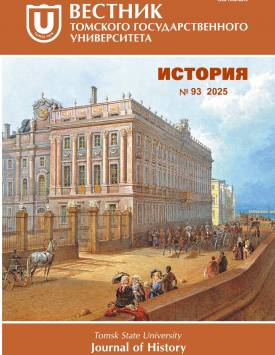The influence of COVID-19 pandemia on migration and state policies of South-Eastern Asia
The article covers the peculiarities of Southeastern Asian countries measures taken to counter the spread of coronavirus in the region. The research is based mainly on the World Bank statistics concerning economic indexes of the countries in the region, the analysis of measures taken by the countries concerned as well as the documents taken within the Association of Southeast Asian Nations (ASEAN) format. It is argued that most measures taken by the countries were identical, however, the success of their implementation was different. Thus, Singapore, Thailand and Vietnam were relatively successful in countering the spread of coronavirus. The ways Malaysia and Cambodia countered coronavirus is criticized as well as measures taken by Indonesia did not seem to be very effective. However, each country had to prioritize its own citizens' health, thus, making such vulnerable groups as labour migrants and asylum seekers even more endangered. Countries of South-Eastern Asia depend a lot on international migration both inside the region and from the region to other countries of the world. Travel restrictions adopted worldwide complicated life of international labour migrants originating from South-Eastern Asia as well as their households relying on remittances. Thus, the faster host economies recover, the faster recovery in countries of origin is possible. Therefore, relatively optimistic forecasts on GDP changes in South-Eastern Asian countries within the following years provides the chance for the region to recover rather quickly, unless new restrictions are adopted due to virus mutations. Travel restrictions also made it more difficult for asylum seekers to reach safe territories. The receiving countries were blamed for governing their borders in the excessively strict way causing even the breaches of human rights. However, the pandemic situation provides a temporary excuse for the states they take advantage of. Current situation with vaccination against coronavirus is different in the countries of the region, thus, impeding complete restoration of regional migration flows. Countries of South-Eastern Asia used to have different initial economic and social conditions before the pandemia making them complementary and to a certain extent interdependent via international migration. Although the initial responses to pandemia were national ones, there is also the need to cooperate in ASEAN as well to guarantee the aims of the Association are still being achieved. The authors declare no conflicts of interests.
Keywords
pandemic,
Southeast Asia,
migration,
politics,
ASEANAuthors
| Azrakhaila Syafina Juni | Tomsk State University | kylazzraa@gmail.com |
| Pogorelskaya Anastasia M. | Tomsk State University | pogorelskaya@mail.tsu.ru |
Всего: 2
References
Kraemer et al. The effect of human mobility and control measures on the COVID-19 epidemic in China // Science. 2020. URL: https://www.science.org/doi/ (accessed: 07.12.2021).
Coronavirus disease 2019 (COVIF-19) Situation Report 88 // World Health Organization/ 2021. URL: https://www.who.int/docs/default-source/coronaviruse/situation-reports/20200417-sitrep-88-covid-191b6cccd94f8b4f219377bff55719a6ed.pdf?sfvrsn=ebe78315_6 (accessed: 01.12.2021).
Total number of emigrants at mid-year 2020 // Migration Data Portal, IOM. 2021. URL: https://www.migrationdataportal.org/international-data?i=stock_abs_origin&t=2020&m=2&sm49=35 (accessed: 07.12.2021).
Преображенская А.А., Князев П.Ю. Формирование миграционной системы в Юго-Восточной Азии // Международная торговля и торговая политика. 2018. № 4 (16). С. 71-89.
National Responses to COVID-19 in Southeast Asia // Center for Strategic International Studies. 2021. URL: https://www.csis.org/programs/southeast-asia-program/projects/southeast-asia-covid-19-tracker (accessed: 07.12.2021).
MCO: Immigration halts operations against illegal immigrants // Malay mail. 2020. 22 Apr. URL: https://www.malaymail.com/news/malaysia/2020/04/22/mco-immigration-halts-operations-against-illegal-immigrants/1859235 (accessed: 01.12.2021).
Impact of COVID-19 on migrant workers in South East Asia - Update 3 // Institute for Human Right and Business. 2021. URL: https://www.ihrb.org/focus-areas/covid-19/covid-19-migrant-workers-south-east-asia-update-3 (accessed: 07.12.2021).
Malaysia: Allow Rohingya refugees ashore // Human Rights Watch. 2021. URL: https://www.hrw.org/news/2020/04/18/malaysia-allow-rohingya-refugees-ashore (accessed: 01.12.2021).
Circuit Breaker extension and tighter measures: What you need to know. URL: https://www.gov.sg/article/circuit-breaker-extension-and-tighter-measures-what-you-need-to-knowb (accessed: 01.12.2021).
Ratcliffe R. We're in a prison: Singapore's migrant workers suffer as Covid-19 surges back // The Guardian. 2020. 23 Apr. URL: https://www.theguardian.com/world/2020/apr/23/singapore-million-migrant-workers-suffer-as-covid-19-surges-back (accessed: 01.12.2021).
Philippines extends lockdown of main island until end of April // Bloomberg. 2020. 6 Apr. URL: https://www.bloomberg.com/news/articles/2020-04-06/philippine-president-likely-to-extend-lockdown-to-april-30 (accessed: 01.12.2021).
Chorn A., Stromseth J. COVID-19 comes to Cambodia // The Brookings Institution. 2021. 19 May. URL: https://www.brookings.edu/blog/order-from-chaos/2021/05/19/covid-19-comes-to-cambodia/(accessed: 07.12.2021).
Annual Total Population at Mid-Year by region, subregion and country, 1950-2050 (thousands) // United Nations Department of Economic and Social Affairs. 2018. URL: https://population.un.org/wup/Download/(accessed: 07.12.2021).
'Absolutely Unacceptable' COVID-19 Vaccination Rates in Developing Countries. The Development Podcast // The World Bank. 2021. 3 Aug. URL: https://www.worldbank.org/en/news/podcast/2021/07/30/-absolutely-unacceptable-vaccination-rates-in-developing-countries-the-development-podcast (accessed: 07.12.2021).
Migrant Smuggling in Asia and the Pacific: Current Trends and Challenges. Vol. II // UNODC. 2018. URL: https://www.unodc.org/documents/southeastasiaandpacific/Publications/2018/MiAR_II_July_2018.pdf (accessed: 07.12.2021).
Unemployment, total (% of total labor force) // International Labour Organization, the World Bank. 2021. URL: https://data.worldbank.org/indicator/SL.UEM.TOTL.ZS?locations=LA-KH-MY-MM-TH-BN-SG-VN-PH-ID (accessed: 07.12.2021).
World Migration Report 2020 // International Organization for Migration. 2020. URL: https://publications.iom.int/system/files/pdf/wmr_2020.pdf (accessed: 07.12.2021).
Personal remittances, received (current US$) - Brunei Darussalam, Vietnam, Indonesia, Cambodia, Lao PDR, Malaysia, Myanmar, Singapore, Thailand, Philippines, Timor-Leste // The World Bank. 2020. URL: https://data.worldbank.org/indicator/BX.TRF.PWKR.CD.DT?end=2020&locations= BN-VN-ID-KH-LA-MY-MM-SG-TH-TL-PH&start=1975&view=chart (accessed: 07.12.2021).
ASEAN Charter // Association of Southeast Asian Nations Secretariat. 2007. 20 Nov. URL: https://asean.org/about-asean/asean-charter/(accessed: 07.12.2021).
Declaration on the Special ASEAN Summit on Coronavirus Disease 2019 (COVID-19) // ASEAN. 2020. 14 Apr. URL: https://asean.org/declaration-of-the-special-asean-summit-on-coronavirus-disease-2019-covid-19/(accessed: 07.12.2021).
ASEAN Strategic Policy Framework on Promoting an Adaptive ASEAN Community of Greater Understanding, Tolerance and a Sense of Regional Agendas Among the Peoples of ASEAN // ASEAN Secretariat. 2021. 26 Oct. URL: https://asean.org/wp-content/uploads/2021/10Z9.-Strategic-Policy-Framework-on-Promoting-an-Adaptive-ASEAN-Community.pdf (accessed: 07.12.2021).

